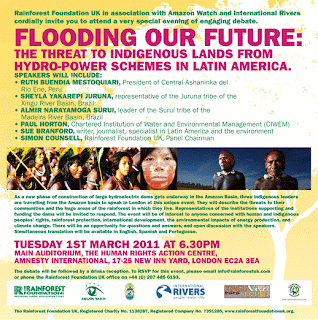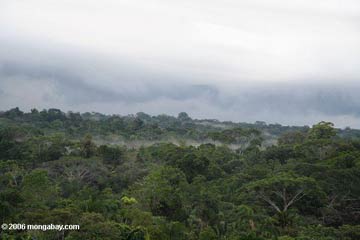Represas de Pakitsapango y Belo Monte gatillarían enorme devastación de la Amazonía aseguran indígenas de visita en Londres
Indigenous Leaders Bring Message to London: Belo Monte and Pakitsapango dam projects would cause huge devastation to the rainforest and river ecosystems.
RECLAMANDO SUS DERECHOS
Indígenas amazónicos denuncian abusos contra el medio ambiente en Londres
http://www.ntn24.com/content/indigenas-amazonicos-denuncian-abusos-contra-medio-ambiente-londres
"Estamos aquí para mostrar a la comunidad internacional que no nos escuchan y que el gobierno brasileño está violando seriamente nuestros derechos", declaró Sheyla Yakarepi Juruna, representante de la tribu Juruna en el río Xingú, en el corazón del estado amazónico de Pará, donde está prevista la construcción de la represa de Belo Monte, que sería la tercera mayor del mundo.
Sheyla Yakarepi Juruna, el jefe Almir Narayamoga Surui, líder de la tribu Surui en la zona del río Madeira, en el estado septentrional brasileño de Rondonia, y Ruth Buendía Mestoquiari, presidenta de la organización Central Ashaninka del río Ene, en Perú, culminan en la capital británica una gira europea de sensibilización de 10 días que ya les llevó a Oslo, Ginebra y París.
En el río Madeira, afluente del Amazonas, hay otras dos grandes represas en construcción, y el gobierno brasileño, que busca garantizar la futura seguridad energética de su nación emergente, ha firmado un acuerdo con su homólogo de Perú para construir y operar seis hidroeléctricas en territorio peruano, entre ellas la de Paquitzapango en las tierras de los Ashaninka.
"La mayoría de los gobiernos latinoamericanos que firmaron el convenio 169 de la OIT sobre los pueblos indígenas (que establece la obligación de consultar a las comunidades interesadas cada vez que prevean medidas susceptibles de afectarles directamente) no lo respetan", explicó Buendía.
"Ellos prefieren a las compañías petroleras, mineras e hidroeléctricas. Nos quieren sacar los últimos recursos que tenemos en los pueblos indígenas, sin respetar nuestros derechos", agregó.
El miércoles, último día de su visita, los activistas se manifestarán junto con miembros de una coalición de organizaciones no gubernamentales británicas frente a las oficinas londinenses del Banco Nacional de Desarrollo Económico y Social (BNDES) brasileño, principal fuente de financiación de estos proyectos.
AFP
----------

Indigenous leaders take fight over Amazon dams to Europe
Jeremy Hance mongabay.com March 02, 2011
Three indigenous Amazonian leaders spent this week touring Europe to raise awareness about the threat that a number of proposed monster dams pose to their people and the Amazon forest. Culminating in a press conference and protests in London, the international trip hopes to build pressure to stop three current hydroelectric projects, one in Peru, including six dams, and two in Brazil, the Madeira basin industrial complex and the massive Belo Monte dam. The indigenous leaders made the trip with the NGO Rainforest Foundation UK, including support from Amazon Watch, International Rivers, and Rainforest Concern.
"These projects will force my people from their land and end our way of life," Ruth Buendia Mestoquiari, a leader of the tribe Asháninka from Peru, said, about a series of six dams planned in her tribe's region. Peru has entered an agreement with Brazil to build the six massive hydroelectric dams, which will largely provide power to Brazil. One of the dams, the Pakitzapango, will be constructed on a gorge that is the mythological birthplace of the Asháninka people.
"The Brazilian Government is exporting a false development model to my people by pressuring the Peruvian Government to build dams on our lands and using its development bank and its companies to implement these projects that will only bring more poverty, not development," added Mestoquiari. It is estimated that 10,000 Asháninka people will be impacted by the dam to be built on the Ene River, a headwater of the Amazon River.

Mist rising in the Amazon, the world's largest rainforest. Photo by: Rhett A. Butler.
As massive as the Peruvian dams will be, none of them will top the Belo Monte dam. This monster dam, planned on the Xingu River, will be the world's third largest.
"We are here to show the international community that we are not being heard and that the Brazilian Government is seriously violating our rights. It is also consistently violating its own laws. We need to take the mask off of the Brazilian Government to show what they are really doing to our people," said Sheyla Yakarepi Juruna, a representative of the Juruna Tribe, which faces impacts from the proposed dam.
Indigenous groups have been fighting construction of the Belo Monte for decades. Most recently a judge suspended construction on the dam, citing that the contractor, Norte Energia, had pressured Brazil's Environment Agency IBAMA for a go-ahead. However, it remains to be seen if the injunction will be overturned.
A hundred and forty-six large dam projects are currently planned in the Amazon. Critics say the staggering number of dams could turn the rainforest's rivers into stagnant reservoirs. However, Brazil argues that the dams are necessary to power its growing economy.
"In order for the Brazilian economy to grow around 5 per cent per year in the next few years, Brazil needs to add 5,000 megawatts per year to its installed capacity," Mauricio Tolmasquim, of the Brazilian government’s Energy Research Company, told the Financial Times.
The Brazilian government says such dams are 'green' and sustainable, yet studies have shown that dams in the tropics release massive amounts of the potent greenhouse gas, methane, due to rotting vegetation. In some cases hydroelectric dams in the tropics may release more greenhouse gas emissions than equivalent power plants run on coal. In 2007 Brazilian scientists announced they had found a way to extract methane from dam reservoirs, but it is unclear if this technology is available yet or will be used in the new projects. Carbon is also released when rainforest are destroyed by flood or construction.
"The government says it is concerned with green and sustainable development and the protection of human rights, but we see that their practice is quite different. I wonder how the Brazilian government feels; how can they promote projects that could force a people to extinction?" Chief Almir Narayamoga Surui, leader of the Suruí Tribe of the Madeira River basin, said in London.
Brazil is currently working to turn the Madeira basin into an industrial complex, including four dams, two of which are already under construction. The dams have forced communities to move and increased malaria outbreaks; they have also impacted the rivers by increasing erosion and threatening fish populations.
Each of these hydroelectric projects has received significant funding from the Brazilian National Development Bank (BNDES), the world's second largest development bank. Critics say that without the funds from the bank, private industry would not have been interested in such financially risky projects.
"BNDES, by investing in the dams, is investing in the destruction of the Amazon. We are being treated like animals—all our rights are being violated," said Sheyla Juruna at a protest yesterday outside BNDES headquarters in London.
Judge suspends Brazil's monster dam: contractor 'imposing' its interests
(02/27/2011) Construction on Brazil's planned mega-dam, the Belo Monte, has been ordered suspended by a federal judge, citing unmet environmental and social conditions. Just last month, the hugely controversial dam, was handed a partial license from Brazil's Environmental Agency (IBAMA). However, the judge, Ronaldo Destêrro, found that the partial license, the first of its kind in Brazil, was granted under pressure from the dam's contractor, Norte Energia or NESA.
Half a million people sign petition against Belo Monte, Brazilian mega-dam
(02/08/2011) In a protest today in Brasilia, Brazil, indigenous people delivered a petition to authorities signed by 500,000 people calling on them to cancel the controversial Belo Monte dam. They hope the petition, organized by online activist group Avaaz, will help convince Brazil's new president, Dilma Rousseff, to cancel the project. However, actions by Brazil's first female president have pushed the dam forward.
------------------------------------------
Indigenous Leaders Bring Message to London
The proposed Belo Monte dam in Brazil and the proposed Pakitsapango dam in Peru - both reported in earlier Cool Earth News items - have driven these three leaders from different Amazonian communities to get together and travel the world to jointly raise awareness of their plight. Both dams are projects headed by Electrobrasil, Brazil's state owned electricity generating company and represent only a small percent of the total hydro electric schemes proposed by them for the Amazon Basin.

Both Belo Monte and Pakitsapango projects would cause huge devastation to the rainforest and river ecosystems as well as forcing scores of thousands of indigenous peoples from their best traditional village and garden sites. Their joint message is for the controversial schemes to be halted.

Sheyla Yakarepi, an indigenous leader from the Juruna people in Para, Brazil, has been fighting to protect their land for more than 20 years and is an unwavering opponent of the Belo Monte proposal. Also from Brazil, Almir Narayamoga represents the Surui indigenous nation and is committed to working for the rights of indigenous peoples.

From the Peruvian Amazon, the third indigenous leader is Ruth Buendia, President of the Central Ashaninka del Rio Ene, which represents most of the Ashaninka communities on the river where the Pakitsapango dam threatens to be built. She, too, battles energetically against this dam, one of six proposed by the Brazilians for development in Peru, together forming an enormous US$16 billion investment. Ruth argues that in international law a megaproject such as this can not go ahead without full consultation and consent by the communities effected. No social and/or environmental impact assessment has been completed yet and the communities have not been consulted.
The three leaders will be in London for only a few days, during which they plan to speak at an event organised by the Rainforest Foundation and lead a demonstration with the help of Survival International. More information on these dam projects and the campaigns against them can be found on the International Rivers website.
------------------------------------------
FLOODING OUR FUTURE SPEAKERS EVENT, TUESDAY MARCH 1 - Rainforest ...17 Feb 2011... hydroelectric dams gets underway in the Amazon Basin, three impassioned indigenous leaders are travelling from their homelands to London ...
www.rainforestfoundationuk.org › Home › News - En caché
Indigenous leaders take fight over Amazon dams to Europe 2 Mar 2011 ... Three indigenous Amazonian leaders spent this week touring Europe to ... monster dams pose to their people and the Amazon forest. ... Chief Almir Narayamoga Surui, leader of the Suruí Tribe of the Madeira River basin, said in London. ... The dams have forced communities to move and increased malaria ...
news.mongabay.com/2011/0302-hance_amazon_dams.html
Indigenous Leaders Bring Message to London - Protecting ...From the Peruvian Amazon, the third indigenous leader is Ruth Buendia, ... of the Ashaninka communities on the river where the Pakitsapango dam threatens to be built. ... No social and/or environmental impact assessment has been completed yet ... The three leaders will be in London for only a few days, during which ...
www.coolearth.org/.../indigenous-leaders-bring-message-to-london-1586.html - En caché



